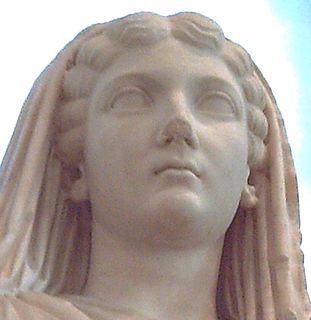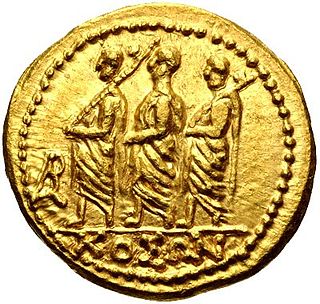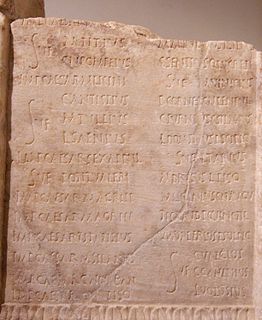Related Research Articles

The cursus honorum was the sequential order of public offices held by aspiring politicians in the Roman Republic and the early Roman Empire. It was designed for men of senatorial rank. The cursus honorum comprised a mixture of military and political administration posts; the ultimate prize for winning election to each 'rung' in the sequence was to become one of the two consuls in a given year. Each office had a minimum age for election; there were also minimum intervals between holding successive offices and laws forbade repeating an office.

Tribune was the title of various elected officials in ancient Rome. The two most important were the tribunes of the plebs and the military tribunes. For most of Roman history, a college of ten tribunes of the plebs acted as a check on the authority of the senate and the annual magistrates, holding the power of ius intercessionis to intervene on behalf of the plebeians, and veto unfavourable legislation. There were also military tribunes, who commanded portions of the Roman army, subordinate to higher magistrates, such as the consuls and praetors, promagistrates, and their legates. Various officers within the Roman army were also known as tribunes. The title was also used for several other positions and classes in the course of Roman history.

The gens Livia was an illustrious plebeian family at ancient Rome. The first of the Livii to obtain the consulship was Marcus Livius Denter in 302 BC, and from his time the Livii supplied the Republic with eight consuls, two censors, a dictator, and a master of the horse. Members of the gens were honoured with three triumphs. In the reign of Augustus, Livia Drusilla was Roman empress, and her son was the emperor Tiberius.

A lictor was a Roman civil servant who was an attendant and bodyguard to a magistrate who held imperium. Lictors are documented since the Roman Kingdom, and may have originated with the Etruscans.

The gens Aemilia, originally written Aimilia, was one of the greatest patrician families at ancient Rome. The gens was of great antiquity, and claimed descent from Numa Pompilius, the second King of Rome. Its members held the highest offices of the state, from the early decades of the Republic to imperial times. The Aemilii were almost certainly one of the gentes maiores, the most important of the patrician families. Their name was associated with two major roads, an administrative region of Italy, and the Basilica Aemilia at Rome.

Gaius Servilius Ahala was a 5th-century BC politician of ancient Rome, considered by many later writers to have been a hero. His fame rested on the contention that he saved Rome from Spurius Maelius in 439 BC by killing him with a dagger concealed under an armpit. This may be less historical fact and more etiological myth, invented to explain the Servilian cognomen "Ahala"/"Axilla", which means "armpit" and is probably of Etruscan origin.

A dictator was a magistrate of the Roman Republic, entrusted with the full authority of the state to deal with a military emergency or to undertake a specific duty. All other magistrates were subordinate to his imperium, and the right of the plebeian tribunes to veto his actions or of the people to appeal from them was extremely limited. In order to prevent the dictatorship from threatening the state itself, severe limitations were placed upon its powers, as a dictator could only act within his intended sphere of authority, and was obliged to resign his office once his appointed task had been accomplished, or at the expiration of six months. Dictators were frequently appointed from the earliest period of the Republic down to the Second Punic War, but the magistracy then went into abeyance for over a century, until it was revived in a significantly modified form, first by Sulla between 82 and 79 BC, and then by Julius Caesar between 49 and 44 BC. The office was formally abolished after the death of Caesar, and not revived under the Empire.
Titus Larcius was a Roman general and statesman during the early Republic, who served twice as consul and became the first Roman dictator.

The gens Junia was one of the most celebrated families of ancient Rome. The gens may originally have been patrician, and was already prominent in the last days of the Roman monarchy. Lucius Junius Brutus was the nephew of Lucius Tarquinius Superbus, the seventh and last King of Rome, and on the expulsion of Tarquin in 509 BC, he became one of the first consuls of the Roman Republic.
Marcus Aemilius Lepidus was a Roman statesman and general. After the death of Lucius Cornelius Sulla, he joined or instigated a rebellion against the government established by Lucius Cornelius Sulla, demanding a consecutive term as consul late in his year and – when refused – marching on Rome. Lepidus' forces were defeated in a battle near the Milvian Bridge and he fled to Sardinia. He was the father of the triumvir Marcus Aemilius Lepidus and of one of the consuls for 50 BC Lucius Aemilius Lepidus Paullus.

Lucius Papirius Mugillanus Cursor was a celebrated politician and general of the early Roman Republic, who was five times consul, three times magister equitum, and twice dictator. He was the most important Roman commander during the Second Samnite War, during which he received three triumphs.

The gens Cornelia was one of the greatest patrician houses at ancient Rome. For more than seven hundred years, from the early decades of the Republic to the third century AD, the Cornelii produced more eminent statesmen and generals than any other gens. At least seventy-five consuls under the Republic were members of this family, beginning with Servius Cornelius Maluginensis in 485 BC. Together with the Aemilii, Claudii, Fabii, Manlii, and Valerii, the Cornelii were almost certainly numbered among the gentes maiores, the most important and powerful families of Rome, who for centuries dominated the Republican magistracies. All of the major branches of the Cornelian gens were patrician, but there were also plebeian Cornelii, at least some of whom were descended from freedmen.
The celeres were the bodyguard of the Kings of Rome. Traditionally established by Romulus, the legendary founder and first King of Rome, the celeres comprised three hundred men, ten chosen by each of the curiae. The celeres were the strongest and bravest warriors among the early Roman nobility, and were the bravest and most loyal soldiers in the army. The name of celeres was generally believed to have arisen from their celeritas, or swiftness, but Valerius Antias maintained that their first commander was named "Celer", perhaps the same Celer mentioned by Ovid as the foreman of the first fortification built around the Palatine Hill; it was he, rather than Romulus himself, who slew Remus after he overleapt the wall.

The gens Postumia was a noble patrician family at ancient Rome. Throughout the history of the Republic, the Postumii frequently occupied the chief magistracies of the Roman state, beginning with Publius Postumius Tubertus, consul in 505 BC, the fifth year of the Republic. Although like much of the old Roman aristocracy, the Postumii faded for a time into obscurity under the Empire, individuals bearing the name of Postumius again filled a number of important offices from the second century AD to the end of the Western Empire.
The gens Servilia was a patrician family at ancient Rome. The gens was celebrated during the early ages of the Republic, and the names of few gentes appear more frequently at this period in the consular Fasti. It continued to produce men of influence in the state down to the latest times of the Republic, and even in the imperial period. The first member of the gens who obtained the consulship was Publius Servilius Priscus Structus in 495 BC, and the last of the name who appears in the consular Fasti is Quintus Servilius Silanus, in AD 189, thus occupying a prominent position in the Roman state for nearly seven hundred years.
Decimus Junius Brutus was a Roman politician who was elected consul in 77 BC.

Aulus Cornelius Cossus was a Roman general from the early Republic. He is most famous for being the second Roman, after Romulus, to be awarded the spolia opima, Rome's highest military honor, for killing the commander of an enemy army in single combat. Only four Romans ever achieved this feat, but the final winner was officially denied the honor by a jealous Consul Caesar Octavianus who insisted the honor was limited exclusively to Roman commanders. Cornelius Cossus proves otherwise.
Gaius Furius Pacilus Fusus was a Roman statesman of the early Republic. He was a descendant of the ancient patrician house of the Furii, which filled the highest offices of the Roman state from the early decades of the Republic to the first century AD. He was probably closely related to Quintus Furius Pacilus Fusus, whom Livy mentions as Pontifex Maximus in 449 BC, and was likely the father of Gaius Furius Pacilus, consul in 412 BC.
Aulus Cornelius Cossus Arvina was a Roman politician and general who served as both consul and Magister Equitum twice, and Dictator once in the mid 4th century BC.
References
- 1 2 3 4 5 6 7 Dictionary of Greek and Roman Antiquities, pp. 404–408 ("Dictator").
- ↑ Livy, i. 15.
- ↑ Harper's Dictionary of Classical Antiquities, pp. 307, 1601 ("Celeres", "Tribunus", No. 1)
- ↑ Livy, i. 60, ii. 6.
- ↑ Dictionary of Greek and Roman Biography and Mythology, vol. I, pp. 507, 508 ("Brutus", No. 1).
- ↑ Livy, ii. 17.
- 1 2 3 4 5 6 Oxford Classical Dictionary, p. 339 ("Dictator").
- 1 2 3 Harper's Dictionary of Classical Antiquities, pp. 509, 510 ("Dictator").
- ↑ Livy, ii. 17, 18.
- 1 2 Oxford Classical Dictionary, p. 638 ("Magister Equitum").
- ↑ Oxford Classical Dictionary, p. 429 ("Fasces").
- ↑ Harper's Dictionary of Classical Antiquities, p. 993 ("Magister", No. 6).
- ↑ Dictionary of Greek and Roman Biography and Mythology, vol. III, pp. 933–943 ("Sulla", No. 5).
- ↑ Oxford Classical Dictionary, p. 1021 ("Sulla", No. 1).
- ↑ Dictionary of Greek and Roman Biography and Mythology, vol. I, pp. 539–555 ("Caesar", No. 18); pp. 214–216 ("Antonius", No. 12); vol. II, pp. 766–768 ("Lepidus", No. 17).
- ↑ Dictionary of Greek and Roman Biography and Mythology, vol I, pp. 539–555 ("Caesar", No. 18); pp. 424–431 ("Augustus"); pp. 584, 585 ("Calvinus", No. 4).
- ↑ Grant, The Roman Emperors.
- ↑ Dictionary of Greek and Roman Biography and Mythology, vol. I, pp. 424–431 ("Augustus").
- ↑ Oxford Classical Dictionary, p. 638 ("Magister Militum").